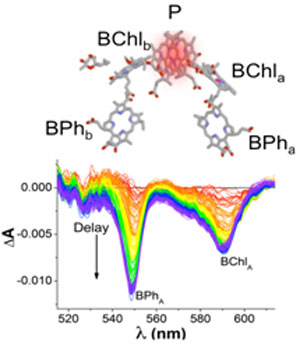| Apr 19, 2012 |
Shedding light on nature's nanoscale control of solar energy
|
|
(Nanowerk News) Nature's process for storing solar energy occurs in light-absorbing protein complexes called photosynthetic reaction centers (RCs). Across billions of years of evolution, Nature has retained a common light-absorbing hexameric cofactor core for carrying out the very first chemical reaction of photosynthesis, the light-induced electron transfer across approximately 3 nm. This process has direct analogies to light-driven charge separation in photovoltaic devices.
|
|
A team of users from the Notre Dame Radiation Laboratory and Argonne's Chemical Sciences & Engineering Division working with the Center for Nanoscale Materials (CNM) Nanophotonics Group have carried out experiments that shed new light on how this process occurs ("Cofactor-specific photochemical function resolved by ultrafast spectroscopy in photosynthetic reaction center crystals").
|
 |
| A schematic of the Rhodobacter sphaerodes hexameric core, featuring the "special pair" (P) of degenerate bacteriochlorophyll (BChl) molecules, and the active (a) and inactive (b) arms of BChl and bacteriopheophytin (BPh) molecules. The transient absorption (ΔA) spectra acquired following selective excitation of P are shown.
|
|
Using polarization selective ultrafast spectroscopy on RC single crystals, the team was able to resolve cofactor-specific photochemistry and identify the nanometer-scale delocalized character of the first light-generated excited states.
|
|
This work is significant because overlapping spectral features of the cofactors have up to now precluded clear resolution of the spectral and temporal response of the individual cofactors to photon absorption, and limited our understanding of the complex photochemical function in RCs. Using the CNM's ultrafast transient absorption spectrometers, individual cofactors in RCs were monitored through careful orientation of the polarizations of the pump and probe pulses relative to the crystallographic axes of the single crystals.
|
|
The impact of this work is that it provides a clearer, more detailed picture of the first steps in photosynthetic energy conversion, identifies a role for delocalized excited-states, and provides new experimental and data analysis approaches for studying the unusual efficiency of light harvesting and charge separation processes in natural photosystems.
|

